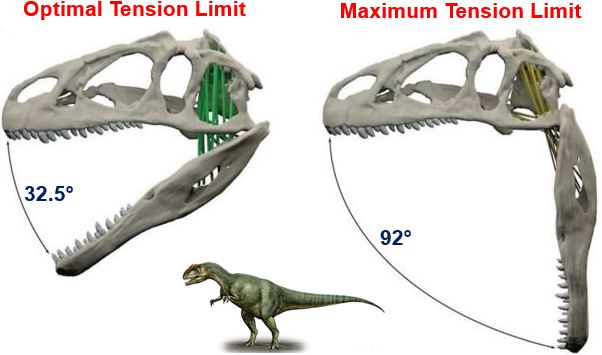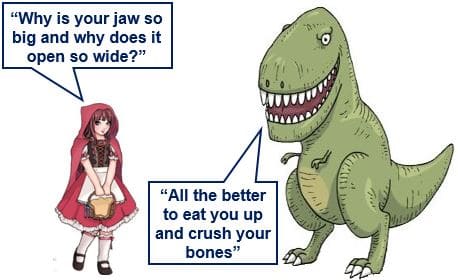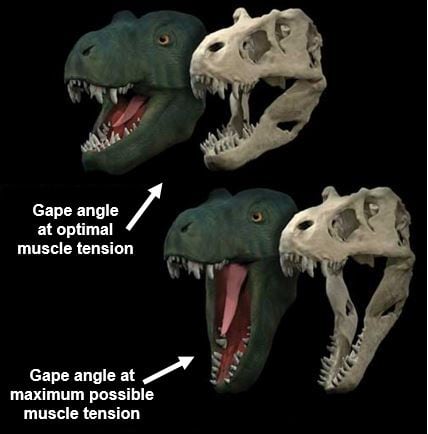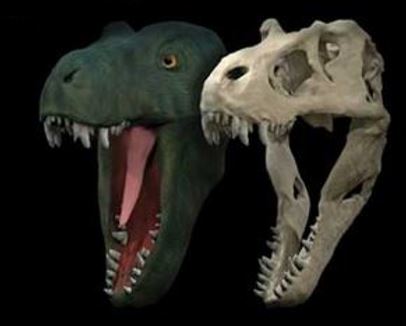If Little Red Riding Hood had met T. rex (Tyrannosaurus rex) instead of the Big Bad Wolf, it would have told her its giant jaw opened super-wide and had razor-sharp teeth 15 centimeters (5.9 inches) long – all the better to eat her with and crush her bones. T. Rex jaw features were typical of meat-eating theropod dinosaurs.
A new study from the University of Bristol in England found that what dinosaurs ate was closely associated with how wide they could open their jaws.
Using computer analyses and digital models, Dr. Stephan Lautenschlager, who works at Bristol’s School of Earth Sciences, studied the muscle strain when the jaws of three different theropod dinosaurs opened, and compared the results with their dietary habits.
 Gape angles at optimal and maximum tension limit for Allosaurus fragilis. (Image: Royal Society Publishing)
Gape angles at optimal and maximum tension limit for Allosaurus fragilis. (Image: Royal Society Publishing)
Theropods were carnivorous dinosaurs of a group whose members were typically two-legged and ranged from small and delicately built to extremely large. The word Theropod comes from the Greek for ‘beast footed’. They were the largest meat-eaters ever to walk the Earth.
Relationship betweeen jaw gape and feeding style
Dr. Lautenschlager said:
“Theropod dinosaurs, such a Tyrannosaurus rex or Allosaurus, are often depicted with widely-opened jaws, presumably to emphasise their carnivorous nature. Yet, up to now, no studies have actually focused on the relation between jaw musculature, feeding style and the maximal possible jaw gape.”
The Study looked at three dinosaurs:
– Tyrannosaurus rex: also called T. rex, was a large, carnivorous theropod with a huge skull and 15cm-long teeth.
– Allosaurus fragilis: – a theropod that was slightly smaller than T. rex, but predatory and meat-eating.
– Erlikosaurus andrewsi: closely related to the two theropods above, but a plant-eating animal.
 T. rex was a much more deadly predator than the Big Bad Wolf.
T. rex was a much more deadly predator than the Big Bad Wolf.
Dr. Lautenschlager said:
“All muscles, including those used for closing and opening the jaw, can only stretch a certain amount before they tear. This considerably limits how wide an animal can open its jaws and therefore how and on what it can feed.”
Dr. Lautenschlager created detailed computer models to simulate jaw opening and closing in order to fully understand the relationship between jaw gape and muscle strain – he also measured the length changes in the digital muscles.
He compared the muscle strain and maximal jaw gape of modern-day crocodiles and birds – relatives of dinosaurs – to those of Erlikosaurus andrewsi, T. rex and Allosaurus fragilis.
 Life reconstruction and skull model of T. rex showing the jaw gape at optimal position to produce muscle force, and the maximal possible jaw gape. (Image: University of Bristol. Credit: Stephan Lautenschlager)
Life reconstruction and skull model of T. rex showing the jaw gape at optimal position to produce muscle force, and the maximal possible jaw gape. (Image: University of Bristol. Credit: Stephan Lautenschlager)
Carnivores had a wider gape than herbivores
He found that Tyrannosaurus and Allosaurus – both carnivores – were capable of an extremely wide gape (up to 90 degrees), compared to the herbivorous Erlikosaurus, whose gape reached just 45 degrees.
T. Rex could produce a sustained muscle force for a very wide range of jaw muscles, which would be needed to bite through meat and skin, and also to crush bone.
Dr. Lautenschlager said:
“We know from living animals that carnivores are usually capable of larger jaw gapes than herbivores, and it is interesting to see that this also appears to be the case in theropod dinosaurs.”
Citation: ‘Estimating cranial musculoskeletal constraints in theropod dinosaurs,’ Stephan Lautenschlager. Royal Society Open Science. Published 4 November 2015.DOI: 10.1098/rsos.150495.
Video – Jaw gape cycles & strain factors
This video shows gape cycles and strain factors for modern species of crocodiles and birds in comparison with Allosaurus fragilis, Tyrannosaurus rex and Erlikosaurus andrewsi.

